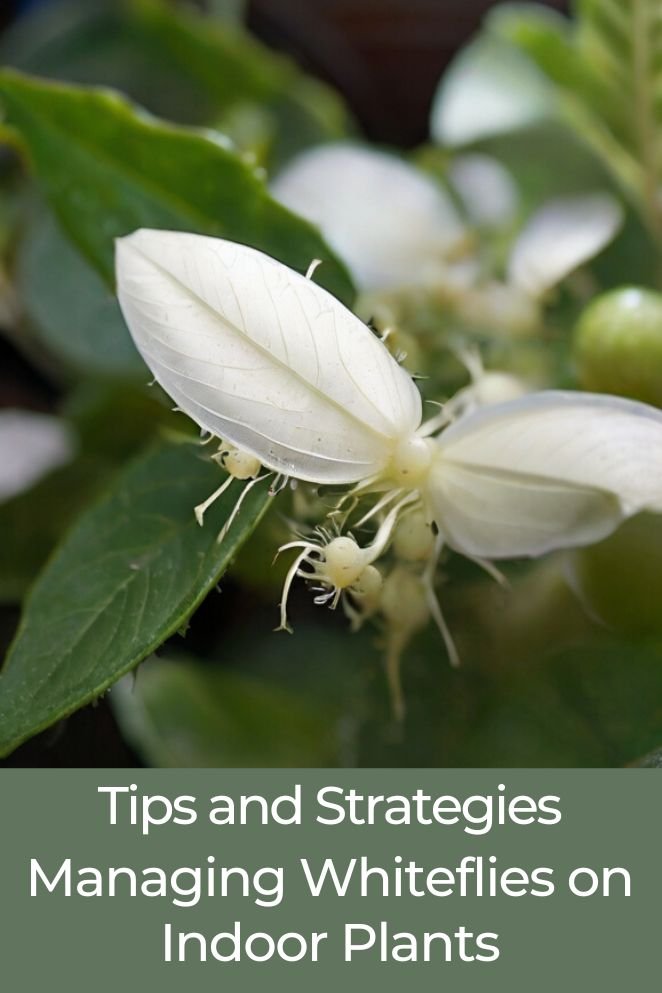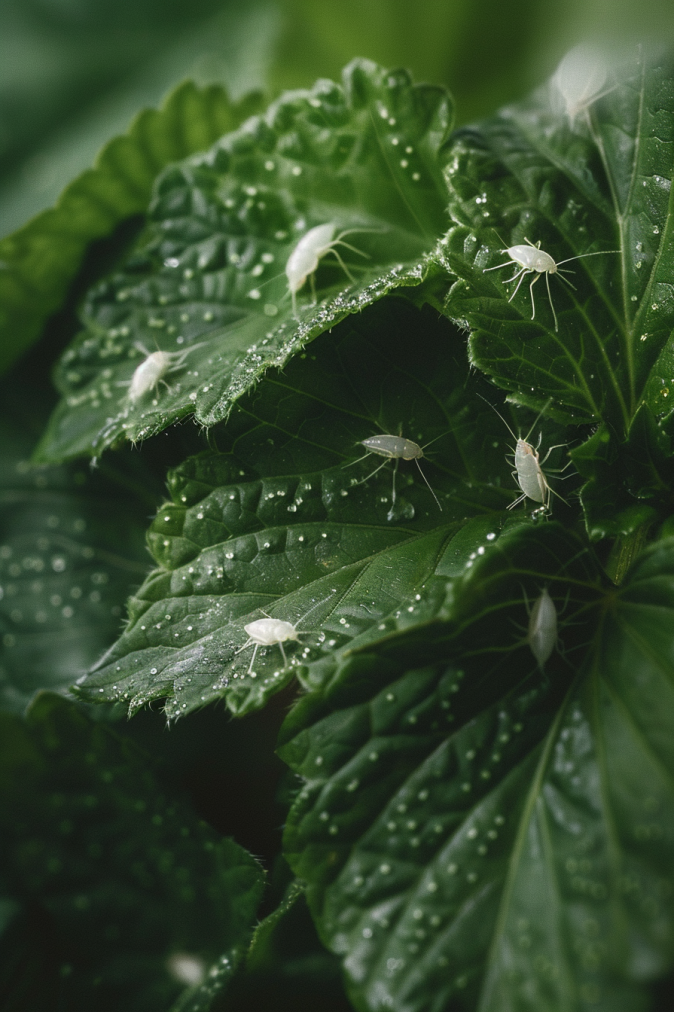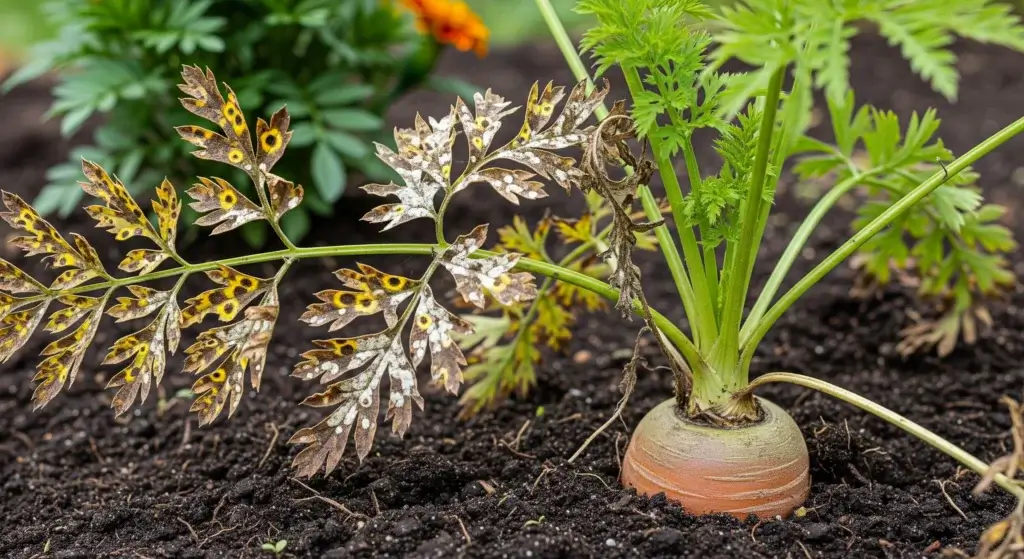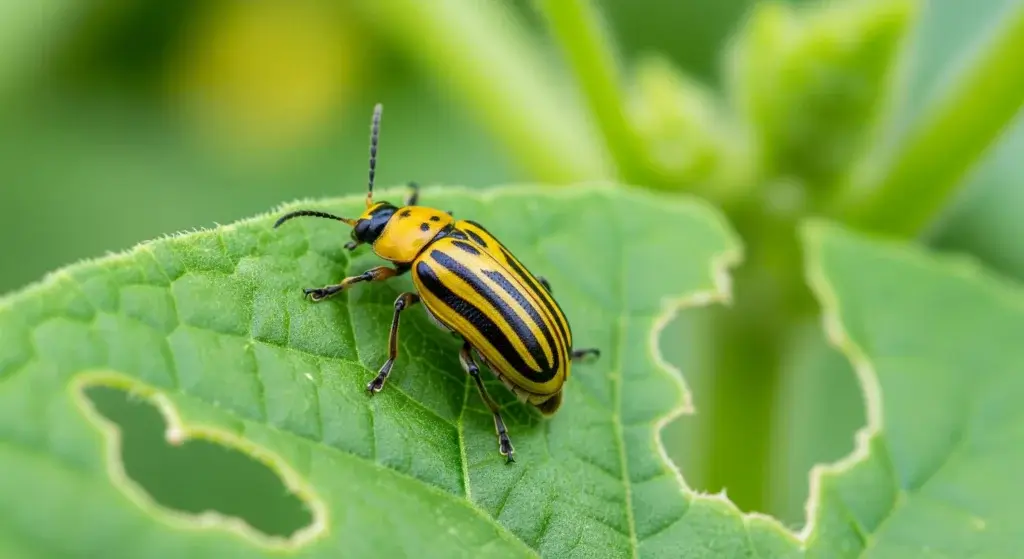
Welcome to our comprehensive guide on combating whitefly infestations on indoor plants!
If you’ve ever battled these pesky insects, you know how frustrating they can be.
But fear not, because we’re here to equip you with the knowledge and strategies you need to protect your beloved indoor greenery.
About Whitefly
Despite their name, whiteflies are not true flies but belong to the same order as aphids and scales (Hemiptera).
Adults are tiny, measuring around 1/12 inch, with white wings dusted with a waxy powder and yellowish bodies.
They primarily target the undersides of leaves, where they insert their mouthparts and suck out vital plant juices.
Whiteflies are not picky eaters when it comes to indoor plants, they have a voracious appetite for plant sap.
- Read also: A Guide to Organic Whitefly Control
- Read also: Whitefly vs. Aphid – Know the Difference
How Whiteflies Damage Indoor Plants
Whiteflies pose a serious threat to your cherished indoor plants, inflicting damage through both their feeding habits and the transmission of diseases.
Delving deeper, let’s explore how these minuscule pests can wreak havoc on your greenery.:
Draining plant sap
Whiteflies feed on plant sap by piercing the phloem tissue with their needle-like mouthparts.
This feeding behavior deprives the plant of essential nutrients and fluids, weakening its overall health and vitality.
As a result, the affected plant may struggle to thrive and exhibit signs of distress.
As whiteflies continue to feed on plant sap, they progressively weaken the plant’s structure and function.
This weakening effect can manifest in various ways, including stunted growth, yellowing leaves, and leaf drop.
Transmission of plant viruses
Certain species of whiteflies are capable of transmitting plant viruses.
These viruses can cause a range of symptoms, including leaf curling, mottling, and distortion, as well as more severe diseases that can lead to plant death.
The transmission of plant viruses by whiteflies exacerbates the damage inflicted on indoor plants and adds another layer of complexity to pest management efforts.

How to Identifying Whitefly Infestation on Indoor Plants
Observing adult whiteflies
Whiteflies are small, winged insects resembling tiny moths.
They typically measure just a few millimeters in length and have a distinctive white or pale-yellow coloration.
When disturbed, adult whiteflies will often take flight in a characteristic fluttering motion, making them noticeable around infested plants.
Inspecting leaves and stems
Take a close look at the undersides of leaves, where whiteflies tend to congregate and lay their eggs.
Look for clusters of tiny, oval-shaped eggs, which may be white or pale yellow in color.
You may also spot the immature stages of whiteflies, known as nymphs, which are smaller and more translucent than adults.
Noticing sticky residue
Whiteflies excrete a sugary substance called honeydew as they feed on plant sap.
This honeydew can accumulate on leaves and stems, creating a sticky, shiny residue.
The presence of honeydew is often accompanied by the growth of black sooty mold, which thrives on the sugary substance and appears as a dark, powdery coating on plant surfaces.
Observing plant symptoms
Keep an eye out for symptoms of whitefly infestation, such as wilting, yellowing leaves, and overall decline in plant health.
While these symptoms can be caused by various factors, they may indicate the presence of whiteflies, especially if other signs of infestation are present.
What Kind of Indoor Plants Whitefly Like The Most
Whiteflies may not be overly selective when it comes to their choice of host plants, but they do exhibit preferences for certain types of indoor greenery.
Let’s delve deeper into the characteristics of indoor plants that are most attractive to whiteflies:
Tender, succulent foliage
Whiteflies are drawn to plants with tender, succulent foliage, as these provide an ample source of nutrients and fluids.
Plants with soft, delicate leaves are particularly vulnerable to whitefly infestations, as they offer easy access for feeding and egg-laying.
High nitrogen content
Whiteflies are known to prefer plants with high levels of nitrogen, as this nutrient promotes lush, vigorous growth.
Indoor plants that receive regular fertilization or are grown in nutrient-rich soil may be more susceptible to whitefly infestations due to their higher nitrogen content.
Preferred host plants
While whiteflies can infest a wide range of indoor plants, certain species are known to be more attractive to these pests than others.
Common indoor plants that whiteflies are particularly fond of include
- Hibiscus: Known for its large, showy flowers and lush foliage, hibiscus plants are often targeted by whiteflies.
- Poinsettia: These popular holiday plants with their colorful bracts and dark green leaves are also highly susceptible to whitefly infestations.
- Tomatoes: Indoor tomato plants, especially those grown in greenhouse environments, are often plagued by whiteflies due to their succulent foliage and high nitrogen content.

Whitefly Preferred Indoor Condition
Understanding the preferred indoor conditions for whiteflies is crucial for effective pest management.
Let’s explore the key factors that make certain indoor environments particularly attractive to whiteflies:
Warm temperatures
Whiteflies prefer warm temperatures ranging from 70°F to 80°F (21°C to 27°C).
In indoor environments, temperatures within this range provide the ideal conditions for whiteflies to thrive and reproduce rapidly.
High humidity levels
Whiteflies are highly attracted to environments with high humidity levels, typically above 50%.
Indoor spaces with poor ventilation or areas near sources of moisture, such as kitchens and bathrooms, create humid conditions that whiteflies find favorable.
Limited air circulation
Whiteflies prefer environments with limited air circulation, as this helps them avoid being dispersed by wind.
Indoor spaces with stagnant air, such as enclosed rooms or areas with minimal airflow, provide whiteflies with a conducive environment for feeding and reproduction.
Abundant host plants
Whiteflies are attracted to indoor spaces with a variety of host plants suitable for feeding and egg-laying.
Environments with an abundance of tender, succulent plants provide whiteflies with ample opportunities to feed and reproduce, leading to higher infestation rates.
Access to sunlight
While whiteflies can thrive in indoor environments with artificial lighting, they may be more active and prolific in areas with access to natural sunlight.
Indoor plants placed near windows or under grow lights may attract whiteflies seeking warmth and light for optimal activity.

How to Control Whitefly Infestation on Indoor Plants
Controlling whitefly infestations on indoor plants requires a combination of methods. Here’s a detailed guide on effective strategies:
Pruning
Trim away heavily-infested leaves and stems.
Whiteflies often congregate on the undersides of leaves, so pay special attention to these areas.
Removing infested plant parts helps reduce the whitefly population and prevents further spread.
Natural predators
Introducing beneficial insects like ladybugs and lacewings can help control whitefly populations naturally.
These predators feed on whitefly nymphs and adults, keeping their numbers in check.
You can purchase these beneficial insects from gardening stores or online suppliers.
Neem oil
Neem oil is derived from the seeds of the neem tree and acts as a natural insecticide.
It suffocates whiteflies upon contact and also has repellent properties, deterring them from infesting your plants further.
Mix neem oil with water according to the instructions on the product label and spray it onto affected plants, ensuring thorough coverage, especially on the undersides of leaves.
Insecticidal soap
Insecticidal soap disrupts the cell membranes of whiteflies, leading to their demise. It’s an effective and environmentally friendly option for controlling whitefly infestations.
Purchase a commercial insecticidal soap or make your own by mixing mild liquid soap (such as castile soap) with water.
Spray the solution onto affected plants, focusing on areas with visible whitefly activity.
Vacuuming
Believe it or not, vacuuming is a practical method for removing whiteflies from indoor plants.
Use a handheld vacuum with a soft brush attachment to gently suck up whiteflies from the foliage.
Be careful not to damage the plants in the process. Dispose of the collected whiteflies in a sealed bag to prevent their escape.
Preventing Whitefly Infestations on Indoor Plants
Prevention is always better than cure when it comes to whiteflies. Here are some tips to keep these pests at bay:
Quarantine new plants
Before introducing any new plant to your collection, isolate it for a week or two.
Examine it thoroughly for whiteflies and other pests before integrating it with your existing greenery.
Maintain cleanliness
Regularly clean plant leaves to remove dust and debris where whiteflies can lay their eggs.
Maintain healthy plants
Stress weakens plants and makes them more susceptible to pests.
Ensure your plants receive proper lighting, watering, and fertilization according to their individual needs.
This will boost their natural defenses.
Whiteflies thrive in humid environments so avoid overwatering your plants.
Promote good air circulation
Stagnant air favors whiteflies. Use gentle fans or open windows to create air movement around your plants, making them less hospitable for these pests.
Control indoor conditions
Aim for moderate humidity (around 50-70%) and avoid high temperatures (>80°F). These conditions are less favorable for whiteflies.
Inspect regularly
Check your plants frequently, especially the undersides of leaves, for signs of whiteflies, including adult whiteflies, nymphs, eggs, sticky honeydew, and sooty mold.
Early detection is key to successful control.

- Read also: Treating Whitefly on Plants
- Read also: Whitefly Resistant Plants
Conclusion
Whitefly infestations can be a headache for indoor gardeners, but with the right knowledge and proactive measures, you can keep them under control.
Remember to stay vigilant, act promptly at the first sign of infestation, and employ a combination of natural and preventive methods for long-term success.
FAQs
While whiteflies themselves aren’t harmful to humans, their feeding activity can weaken plants and make them more susceptible to other pests and diseases.
Yes, whiteflies are capable of flying short distances, but they are primarily spread through infected plant material and wind currents.
It’s a good idea to inspect your plants for whiteflies regularly, especially during the warmer months when their populations tend to peak.



